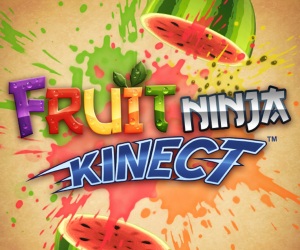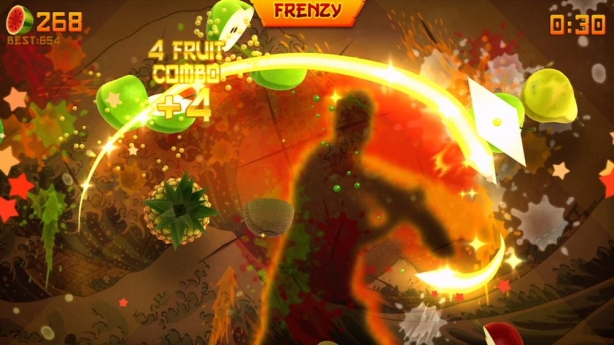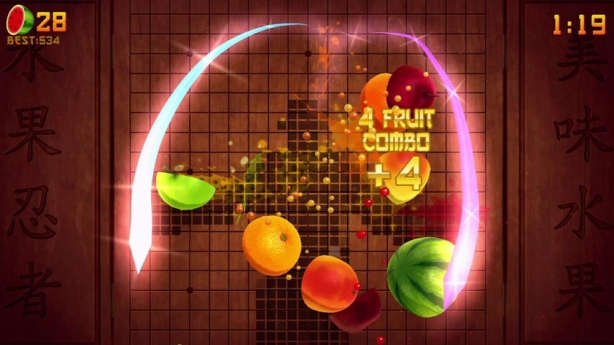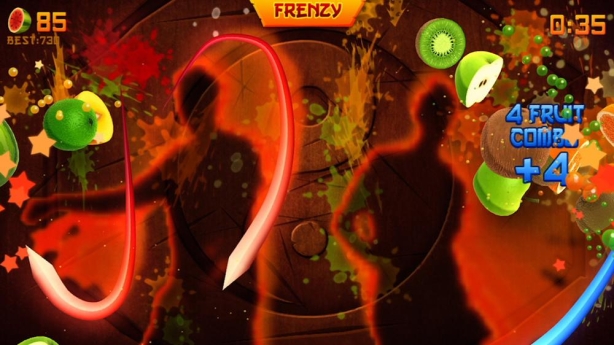Fruit Ninja Kinect Review
 Game: Fruit Ninja Kinect
Game: Fruit Ninja Kinect
Developer: Halfbrick
Publisher: Microsoft Game Studios
Available on: Xbox LIVE Arcade
The growth of iOS and Android platforms as legitimate gaming devices has brought us a deluge of simple, yet highly addictive casual games. The ability to dip in and out of these games whenever you like, coupled with the simple concept and easy to pick up controls, has led to a revolution in the way people play games on the move. Some of these games have transitioned well from handheld to console or vice versa, whereas others would suffer from the loss of direct control provided by the touch screen interface. But how would these games fare when ported to Kinect? Halfbrick has taken the slicing gameplay of its Fruit Ninja title and taken that step into motion control with Microsoft, but how does it fare?
When the Nintendo Wii first came onto the market, the first title many gamers requested was a Star Wars Lightsabre game. It seemed so obvious! For years people had pretended to twist around an imaginary Jedi weapon, slicing imaginary opponents, and through the application of motion controls, players realised that they could finally wield the legendary weapon in gaming form. Unfortunately, this has never really happened. Of course, the new Star Wars Kinect game (coming this winter) will rectify that, but it still seemed like a missed opportunity on Wii. Games such as Red Steel did try to fill the sword swinging void, allowing players to wield a Kitana against their foes. This never felt like 1:1 control however, and the titles struggled to make their mark on the charts.
Perhaps the problem was that these games tried to combine sword slicing action with gunslinging? Maybe we needed something more basic, more raw. Step forward Fruit Ninja Kinect!
GRAPHICS: There have been few changes made to the graphical presentation between the handheld and Kinect versions of Fruit Ninja. The game retains the same cartoonish, stylised Japanese look that it always had, with all of the assets seemingly reused but given a high definition makeover. This does result in the game looking simple, but having a very clean and polished finish. After all, the game is focused more on control and the experience than the high impact visuals. The graphics are clear and concise, just what they need to be. Different fruit can easily be distinguished so you know which will yield those all important bonus points or multipliers, and which ones are bombs, which will prematurely end your Ninja action.
A few added bells and whistles have been included, such as a range of new effects and filters which are applied when the player gains special power-ups or equips an unlockable secret weapon, but these are all simply extra aesthetic touches rather than something that makes any real difference to the overall experience. Because the game is now making use of Kinect controls, most games implement some sort of player based avatar, to represent where you appear within the action. This of course makes it much easier to track where the player is within the game environment, making it simpler to judge your movements and what is required for you to hit your targets. In Fruit Ninja, this is all handled in quite a subtle manner.The player is simply represented by a shadow. The shadow is a captured image of the actual player following your movements accurately, but because it is a single colour, greyed out avatar, it doesn’t interfere with or overwhelm the existing graphical style. It remains functional, but in the background.

SOUND: Again, the sound in the game isn’t anything particularly special, but it is functional and does all the things you would expect. These effects and the music (which is found only during the menu screens) are both adapted directly from the handheld versions as well. This isn’t an issue, as the music does seem to be of a higher quality, as are the sound effects, and they do their job very well. The slicing, splatting and squishing sounds all help to add some feedback to what is a non-contact control method. A lot of people complain that with Kinect there is no recoil or physical impact for the player. Of course, this does make the title slightly less tactile than the touch-screen versions, but the sound effects do go a long way to replicating the feel that you are actually slicing through these fruits, and they are really exploding and splattering against the wall. The music and other miscellaneous sound effects are all typically Japanese, and whilst they don’t stand out, they help set the scene for the game. This title is playing on the idea that everyone wants to be a Ninja, training in the Dojo with their Sensei, and the sound design further adds to the atmosphere.
GAMEPLAY: For those who are unaware, the basic idea in Fruit Ninja is that the player slices fruit with an invisible blade, originally controlled directly with your finger on a touch-screen, now controlled with the body tracking action of Kinect. A selection of fresh fruit is hurled on-screen, and players must swipe and chop as much as they can. Bonuses are awarded for combos, where the user slices multiple fruits with one action, and in this new version players can use both hands (or their feet) as they wish, in order to chop up as many items of fruit as possible.
There are three main modes of play. The first of these is Classic mode, where there is no time limit on play. The Ninja must make sure they slice every piece of fruit that is flung at them, as they only have three lives. Each missed fruit is a life lost, and once all three are lost, it is game over. If the player reaches a score of 100 (or multiples of 100 thereafter) one life is restored, allowing play to continue longer. To make this mode more difficult, bombs will regularly be thrown on-screen with the fruit. Slice one of these and it is instant game over, no lives are taken into account. This can become very tricky when you get to a stage where there may be six pieces of fruit and three bombs all on the screen at once, but it adds to the challenge of reaching high scores. There is also the addition of the Pomegranate which appears every now and then which must be slashed repeatedly until it bursts, giving the player a big bonus score.
In Arcade Mode you are given sixty seconds in which to set a high score, with missed fruit having no effect. Combos are still rewarded in the same way, however in this game there are added bonus fruits to collect and bombs won’t end your game, just simply remove ten points from your score each time one is hit. There are also power-ups of sort, and these take the shape of different coloured Bananas. The frosty looking one will slow down all fruit and bombs on the screen, making it easier to score combos and avoid explosions. The stripy blue fruit will double your scores for a short period of time and the stripy red one causes a fruit frenzy, where the number of pieces of fruit appearing on screen is radically increased for a set amount of time. These all help to rack up higher scores, and a combination of several diffrent power-ups can yield huge tallies.

The final mode is called the Zen mode. Simply put, you are given ninety seconds, with no bombs, no lives and no power-ups. Simply you against the fruit, trying to score as many combos as you can, to reach a high total. These all provide slightly different experiences ranging from more hectic to slightly more calm and considered gameplay, but when all is said and done, the three modes are terribly similar. Added in for the Kinect version is the Challenge mode. This option simply throws the player into any of the three aforementioned gameplay modes, with a pre-determined target. You may be asked to score over 150 on Zen mode, or over 300 in Arcade. These obviously begin with fairly low totals, but ramp up the difficulty and demands as you complete more and more challenges. It is a nice extra mode to have, but once again, it is simply a recycling or re-packaging of the existing gameplay, and it all begins to feel somewhat samey.
MULTIPLAYER: Both co-operative and competitive multiplayer is included in Fruit Ninja Kinect, with the option to have two players simultaneously playing on-screen at once. The co-operative mode is simply arcade mode, complete with minus-ten scoring bombs and banana power-ups, but allowing for two bodies to join in the action. Depending on how you look at it, this can make the game a lot easier, or a lot harder. For instance, with two people, it is far more likely that someone will hit a power-up when it appears on the screen. Conversely, having two people slashing away at the fruit does make it harder to score a large combo, as you can’t hit as many fruit in one go if someone else has already destroyed half of them.
The competitive mode splits the screen in half, and throws fruit in front of each player, giving them the chance to score as many points as they can. If a player reaches across and slices a fruit intended for the other player (they are surrounded by a red or blue glow, depending on who they are assigned to) that player will be punished with a minus one point deduction, per fruit. Bonus power-ups still whizz across the screen, and will be rewarded to whoever has the quickest reactions to slice it whilst it is on their side of the screen. This mode is also timed, and whoever has the highest score at the end of the timer will win. Wins are added to a tally at the end of the game, but there is very little in the way of a win/loss celebration. The fact that nothing really occurs after a win or that there is no set number of victories to reach in order to end the match (for example) seems a little disappointing. More should have been made about making these match-ups more competitive or more of a spectacle.
A big disappointment is the fact that the game only allows for you to have one profile signed in at once. Therefore, in two-player mode, the second player is never racking up any scores or achievements to apply to their own profile, it all simply applies to the first player. This is a strange decision to make, and seems like a major oversight, as profile tracking is present throughout almost all Xbox 360 games, including Kinect titles. No online multiplayer is included either, and it does result in the feeling that the multiplayer aspects of the game were more of an afterthought, with little care paid to their implementation.

LONGEVITY: Leaderboards are intended to play a big part in the competitive side of this game. As the game is entirely score-based, the title tries to implement weekly and all-time leaderboards, in an attempt to build up a competitive environment. However, as with most online games, these elements don’t tend to prolong the life cycle of a game very much, especially if the core experience isn’t deep enough, and the game does feel shallow. Whereas on the handheld versions of the game, players might regularly dip in and out of the title for one or two minutes, have a quick slice and dice, then go back to their train journey, with Kinect the whole experience isn’t as streamlined. You don’t just jump on the Kinect for a quick game, as the platform isn’t as immediate as a handheld device.
Extras such as the Dojo (where players can track and equip their unlockable items they have earned whilst playing) are fairly pointless. You can change your blade to be more sparkly, introduce an interesting backdrop, or make your shadow avatar more exciting, but none of these really make the game more enjoyable and most players will rarely ever alter these options. The achievements add a little length to the title, but most of these are simply awarded for attaining high scores and they do little to motivate gamers to play the same modes over and over again.
VERDICT: As charming as Fruit Ninja Kinect is, and as much of the spirit of the original is captured, players should expect more from an Xbox LIVE Arcade title. The game is undeniably short-lived and shallow. One of the plus points for the handheld version of the title was that it costs less than one pound to purchase. Spending that kind of money, players can forgive a game that will only provide short bursts of enjoyment here and there, but for 800 Microsoft Points you would like to see more features added, or perhaps some new gameplay ideas.
The gameplay is as smooth and beautiful as it has ever been, and the motion control is very accurate and even feels quite rewarding and immersive as you cut down all fruit in your path. Reaching the scores asked of you in Challenge mode is the kind of goal that can eat away at you, constantly making you want to return for one more game just to beat that score. But that kind of motivation won’t keep you coming back forever. The game does go to show how well the Kinect technology can follow your movements and translate them into on-screen attacks, and this kind of performance bodes well for our future Lightsabre aspirations, but perhaps would have been better released as a Kinect Fun Labs add-on, at a lower price point (similar to Kinect Sparkler). No matter how much fun slicing fruit may be, if all you did all day long was slice fruit, you would soon get bored.







